Abstract
This work presents an efficient design and optimization method based on characteristic mode analysis (CMA) to predict the resonance and gain of wideband antennas made from flexible materials. Known as the even mode combination (EMC) method based on CMA, the forward gain is estimated based on the principle of summing the electric field magnitudes of the first even dominant modes of the antenna. To demonstrate its effectiveness, two compact, flexible planar monopole antennas designed on different materials and two different feeding methods are presented and analyzed. The first planar monopole is designed on Kapton polyimide substrate and fed using a coplanar waveguide to operate from 2 to 5.27 GHz (measured). On the other hand, the second antenna is designed on felt textile and fed using a microstrip line to operate from about 2.99 to 5.57 GHz (measured). Their frequencies are selected to ensure their relevance in operating across several important wireless frequency bands, such as 2.45 GHz, 3.6 GHz, 5.5 GHz, and 5.8 GHz. On the other hand, these antennas are also designed to enable competitive bandwidth and compactness relative to the recent literature. Comparison of the optimized gains and other performance parameters of both structures are in agreement with the optimized results from full wave simulations, which process is less resource-efficient and more iterative.
1. Introduction
Planar antennas are popular in biomedical applications due to their low profile, lightweight, low fabrication cost, and ease of integration with printed circuit board technology [,]. Recently, the evolution of the fifth generation (5G) of communication, the Internet of Things (IoT), big data applications, and vehicular communications [,] have facilitated communication with biomedical devices in therapy and medical diagnosis. These wireless-based assistive technologies are becoming more important in the continuous monitoring of patients’ daily lives in different situations. Wearable antennas should be compact, flexible, and have very low SAR values to be employed for human safety []. Flexible antennas are made from different conductive materials and substrates. The substrate is selected based on its dielectric properties, tolerance to mechanical deformations (bending, twisting, and wrapping), and endurance in external, often challenging environments. In contrast, the choice of conductive material determines the performance of the antenna, such as radiation efficiency.
In full-wave simulations, designers typically optimize a structure’s parameters based on their understanding of its operating principles. Generated wave behaviors and performance parameters are the main guides to determining the next optimization steps for antennas. This is aided by software using methods, such as Integral Equations (IE), which can be solved using the Method of Moments (MoM) for the complex environment with inhomogeneous lossy dielectrics, Finite Elements (FE), Finite Differences in the Time Domain (FDTD), and Finite Integration Technique (FIT). Such software-based antenna design and optimization processes are often iterative and depend heavily on the knowledge, experience, and understanding of designers on specific antenna topologies. This design process can easily be more tedious than expected, considering that more complex and non-arbitrary modern antennas of today are needed to meet growing requirements due to the demands of multi-standard communications. On the contrary, such a design process can be made more systematic and efficient by generating and understanding the physical insights of the structure using Characteristic mode analysis (CMA).
CMA is a method used in electromagnetics to provide insights into the intrinsic resonant qualities of a structure by locating and analyzing the structure’s basic modes [,,,]. This is because each physical structure has a collection of resonant modes, which are dependent on its structure, materials, boundary conditions, and frequency. The notion of CMA was first established in [], then improved by [,]. The presence of the modes is independent of the excitation. However, different forms of excitations at distinct sites can be used to satisfy varied operational requirements. The use of the CMA enables the efficient tuning of an antenna to the correct resonant frequencies and determines the best locations to excite it. This is via the generation of the modes, modal significance, and surface current distributions and observing them over a frequency range of interest. Such a process will then significantly reduce the required calculation time and effort and at the same time, enable more targeted parameter adjustments within the optimization process.
In this work, a method to estimate gain over a wide operating bandwidth from antennas is proposed and applied to two flexible wideband antennas. Wide operating bandwidth is important for wearable antennas to ensure that they can overcome any performance deviation relative to the required frequency range due to the impact of surrounding human tissues []. The various active modes of a radiating structure were studied using the even mode combination (EMC) method. This is based on the principle of summing the electric field magnitudes of the first even dominant modes. To obtain the dominant modes, the modal significance of the structure is first observed at the desired frequency range using CMA. An overview of the EMC method using CMA is as follows:
- First, a radiating patch is designed without its ground, substrate, and excitation.
- Then, an analysis of the structure is performed using CMA to determine the even dominant modes. This is completed by observing the electric field (E-field) results throughout the target operating band.
- A suitable substrate is then added to the antenna prior to the excitation of the radiating patch. This antenna is analyzed to calculate the values of its forward gain.
- Estimation of the forward gain of the antenna takes place using the EMC method. The E-field magnitudes of the first two even modes are combined.
- Finally, the resulting maximum gain of this process provides an estimate of the highest gain value attainable over the frequency band of interest.
As the proposed method aims to improve the time- and resource-efficiency needed in the analysis and optimization effort of a complete antenna’s gain, results from EMC for these two wideband planar monopole antenna examples are compared with results from full wave simulations. Their design and main differences are as follows:
- Antenna 1: a planar monopole with a slotted radiator and fed using a coplanar waveguide (CPW). This antenna was designed on a flexible Kapton polyimide film with a thickness of 0.11 mm, whereas 0.01 mm-thick aluminum foil is used as its conductive sections (radiator, ground plane, and feedline).
- Antenna 2: a planar monopole with a spring-like radiator and fed using a microstrip line. The antenna is designed on textiles, with a 3 mm thick felt as the substrate and ShieldIt conductive textile (0.17 mm thickness) forming the conductive sections.
2. Antenna Configuration
2.1. Antenna 1: Topology
This section presents the compact wideband antenna topology. The radiating patch consists of three main sections: a half-circle (at the bottom), ovoid (in the middle), and rectangular (at the top) patches, and connected with two rectangular arms on the left and right edges of the radiator. The CPW feeding technique is adopted in this work to create extra modes and minimize quality factor (Q), resulting in wide and multiband resonance behavior [,,,,,]. The antenna has an overall volume of 56 × 56 × 0.11 mm3 (0.69 λg × 0.69 λg × 1.37 λg), printed on a Kapton polyimide film flexible substrate (relative permittivity of εr = 3.5, and a loss tangent of 0.002) with 0.11 mm thickness. The antenna has a partial ground plane with a width of 51.44 mm. FEKO simulator software is used to design and analyze the proposed antenna. Figure 1 shows the design of the Antenna 1. The main advantages of the proposed antenna design are as follows:
- The antenna has moderate gain and wide bandwidth in free space.
- Additionally, the fabricated antenna demonstrates good radiative properties when operating on both rigid and curved surfaces, making it suitable for different wearable communications applications.
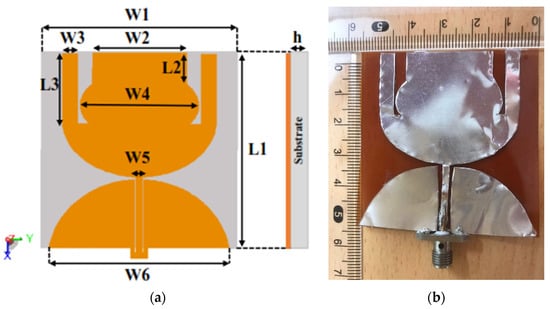
Figure 1.
(a) Configuration of the proposed Antenna 1 with L1 = 56 mm, W1 = 56 mm, L2= 8.922 mm, L3 = 20 mm, W2 = 27 mm, W3 = 4.5 mm, W4 = 33.92 mm, W5 = 2 mm, W6 = 51.44 mm, h = 0.11 mm, (b) fabricated prototype of Antenna 1.
2.1.1. Antenna 1: Design Procedure
The proposed Antenna 1 is designed in four steps, as seen in Figure 2a–d. Different parasitic patches are integrated with the main radiator to improve its performance. The simulation process using CMA includes only the radiating patch as a perfect electrical conductor (PEC) without the substrate, ground, and excitation. The modal significance (MS) parameter, which ranges between 0 < MS ≤ 1 is observed in CMA simulations. Modes with values of MS greater than 0.707 are active modes and have high potential to be excited using the specific structure shown in Figure 2. Then, the MS results in each step of design are compared with the reflection coefficient of the complete antenna (with substrate, ground, and excitation) based on the normal method of moments (MoM) (see Figure 3a–d). The simulation process using CMA provides the natural resonance of the modes, which can help in understanding the antenna operation and estimating the antenna bandwidth based on physical insights from MS in less time.

Figure 2.
Design procedure of the proposed Antenna 1 (a) step 1, (b) step 2, (c) step 3, (d) step 4.

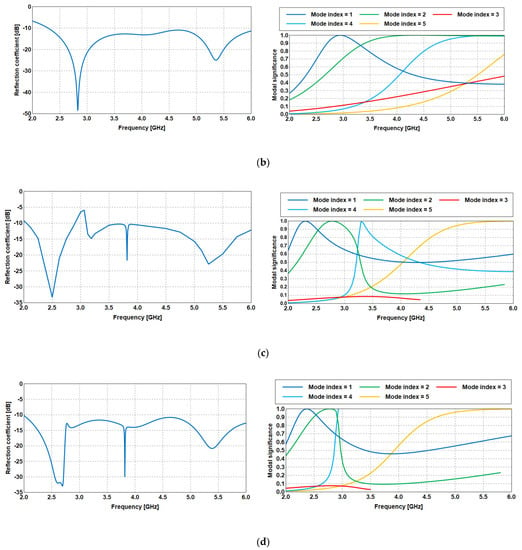
Figure 3.
Design steps: reflection coefficient (left), modal significance (right). (a) Step 1; (b) Step 2; (c) Step 3; (d) Step 4.
The steps involved in the antenna design can be summarized as follows:
- As the first step, a conventional circular patch antenna is designed. In this iteration, the antenna is not matched at the resonant frequencies from 2 to 2.2 GHz. Similarly, no modes are active to cover this range of frequencies, as illustrated in the MS plot in Figure 3a.
- Next, the antenna in the previous step is modified in step 2. A portion from the upper part of the circular patch is removed to achieve miniaturization at the same resonance, as shown in Figure 3b.
- The antenna is further modified by adding two rectangular parasitic patches on the left and right sides of the radiator. It is observed that the antenna operated with a 10-dB reflection coefficient starting from 2 GHz, which is generated by mode 1, as in Figure 3c. However, the reflection coefficient in this step shows a narrowband around 3 GHz, which does not meet the targeted wideband antenna operation.
- To overcome this, the top side of the patch is extended by connecting a rectangular-shaped resonator. Using this step, the proposed antenna achieved a bandwidth from 2 GHz to 6 GHz, as shown in Figure 3d. Some differences between the estimated operating bandwidth using the MoM and CMA approaches originates from the effect of the excitation process in generating the excited modes.
Additionally, to explain the antenna radiation mechanism, the surface current distributions based on CMA on the patch are shown in Figure 4. In the first mode, the current is concentrated near the beginning of the two parasitic arms connected with the left and right sides of the patch at 2.45 GHz and 3.6 GHz. In comparison, the current distribution is extended to include the upper and lower sides of the patch with varying intensities at 5.5 GHz and 5.8 GHz. In mode 2, it is significantly observed that the current flow in the feed line is at 2.45 GHz, 5.5 GHz, and 5.8 GHz, respectively. Here, the current still propagates along the left and right portions of the radiating patch, except at 2.45 GHz.
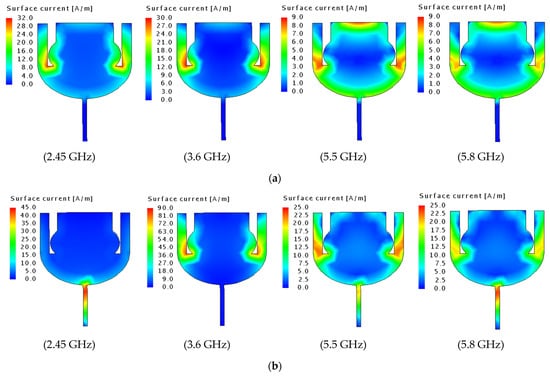
Figure 4.
Surface current distribution using CMA (a) mode 1 (b) mode 2.
2.1.2. Results and Discussions
- Antenna Performance in Free Space
This section presents the results and analysis of the proposed wideband antenna in free space in terms of reflection coefficient, radiation patterns, surface current distributions, efficiency, and gain. First, Figure 5 shows the simulated and measured reflection coefficient of the antenna on the Kapton polyimide film substrate. Simulations showed that the proposed antenna spans a frequency band larger than 4 GHz with an operational range from 2 to 6 GHz, with satisfactory impedance matching. The reflection coefficient reaches a minimum value of −32.21 dB at roughly 2.7 GHz. On the other hand, the measured reflection coefficient indicates that the antenna has a very good impedance matching with a reflection coefficient below −10 dB from 2 to 5.27 GHz. This shows that the antenna has a bandwidth larger than 3.2 GHz.
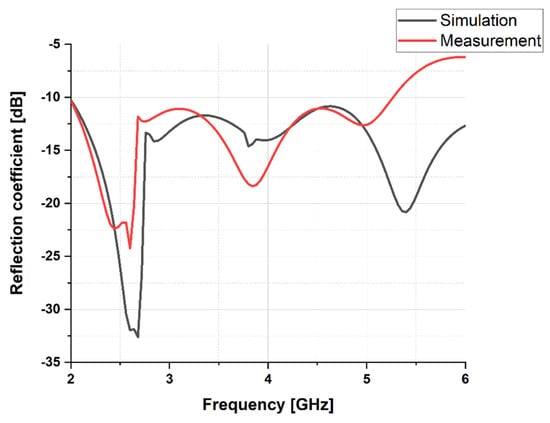
Figure 5.
Simulated and measured reflection coefficients of the designed antenna.
Figure 6a,b illustrates the simulated polar radiation patterns and the co- and cross-polarization of the proposed antenna, respectively. The far-field patterns over a range of frequencies indicate that the antenna featured a quasi-omnidirectional pattern in the major H-plane (θ = 90°), while a bidirectional radiation pattern is found for the E-plane (θ = 0°). As the frequency increases, the lower half of the pattern shows a significant distortion with more ripples. Additionally, it is found that the radiation is reduced from the non-radiating edges that are responsible for cross-polarized radiation, which is mainly caused by the currents on the feeding probes. The designed antenna exhibits a peak gain of 8 dBi at 3.6 GHz, 5 dBi at 2.45 GHz, and 4 dBi at 5.5 GHz and 5.8 GHz, respectively.
- b.
- Gain Estimation using EMC Method based CMA
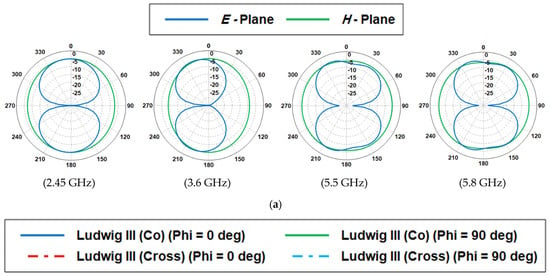

Figure 6.
Simulated far-field pattern of the proposed antenna (a) E-plane and H-plane, (b) Co-pol and Cross-Pol.
The first design example (Antenna 1) depicting the efficiency of this method is presented and explained in detail as follows:
- i.
- Based on characteristic mode (CM) theory, the proposed Antenna 1 is first analyzed with only the perfect conductor (patch) and without any substrate, ground, and excitation to determine the natural modes of resonance.
- ii.
- After the simulation process is performed, the electric field of the first two even modes (mode 2 and mode 4) is obtained from the results, as illustrated in Figure 7.
- iii.
- Next, these two modes are then combined to form a wide specific band (from 2 to 6 GHz) as represented in Equation (1). For example, at 3.7 GHz, the electric field of mode 2 is 5.79 V, whereas it is 6.62 V at mode 4. Then, the EMC method is applied as follows:
EMC (V) = Em2 (V) + Em4 (V)
EMC (V) = 5.79 V + 6.62 V
EMC (V) = 12.42 V
- iv.
- The same procedure is performed for the rest of the frequencies. In Table 1, a set of frequencies is selected to verify the proposed method. The results of EMC in the fourth column are arranged in descending order (from the highest value of the electric field to the lowest), as also seen in Figure 8.
 Table 1. EMC results of a wideband Antenna 1 based on CMA.
Table 1. EMC results of a wideband Antenna 1 based on CMA.
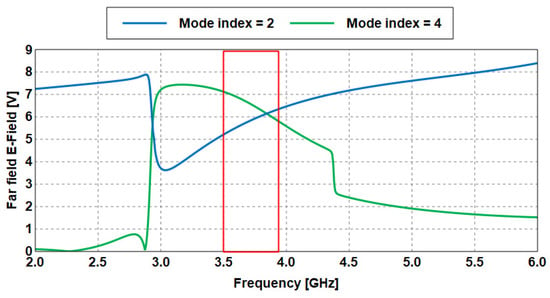
Figure 7.
Electric fields of the wideband antenna based on CMA.
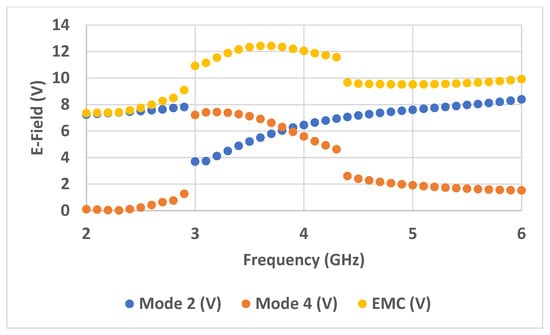
Figure 8.
EMC results of the wideband Antenna 1 based on CMA.
- v.
- Finally, the radiating patch is integrated with the substrate and excitation to form the complete antenna. Analysis indicated that the maximum gain of 3.54 dBi is achieved at 3.83 GHz, as indicated in the red box in Figure 9. Note that the frequency at which a maximum electric field was achieved based on the EMC-based CMA method agrees closely with the frequency of the maximum gain of the overall antenna.
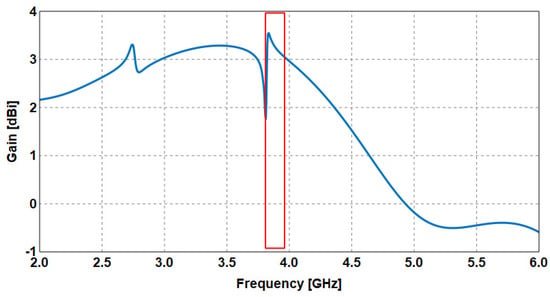 Figure 9. Gain of the wideband antenna.
Figure 9. Gain of the wideband antenna.
2.2. Antenna 2: Topology
For further verification of the proposed method, an additional flexible patch Antenna 2, also referred to as “spring antenna” is used. This antenna featured a compact dimension of 32 × 42 × 3 mm3 (0.38 λg × 0.5 λg × 0.036 λg) and operated from 2.99 GHz to 5.57 GHz with a bandwidth of 73.8% []. Figure 10 illustrates the topology of Antenna 2 designed on a felt textile substrate with a thickness (h) of 3 mm, a dielectric constant of approximately 1.3, and a loss tangent of 0.044. The single-layered substrate ensures a low-profile structure and reduces potential complexities in fabrication and integration with clothing. The top patch and partial bottom ground are made using a ShieldIt conductive fabric. The overall antenna is fed by a microstrip feed line, with its width (Wf) optimized to ensure good impedance matching.
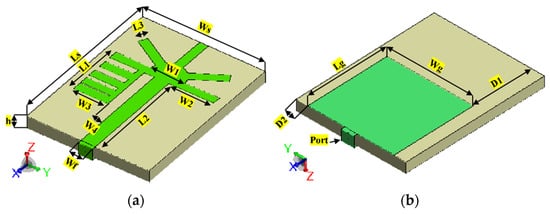
Figure 10.
Configuration of Antenna 2 from [] (a) Front view, (b) Back view. Ls = 42 mm, Ws = 32 mm, L1 = 15.3 mm, L2 = 26.625 mm, L3 = 2.25 mm, W1 = 8.97 mm, W2 = 11.625 mm, W3 = 9 mm, W4 = 2.625 mm, Wf = 3.75 mm, h = 3 mm, Lg = 24 mm, Wg = 25 mm, D1 = 18 mm, and D2 = 3.5 mm.
The steps to calculate the EMC values of Antenna 1 is then applied to Antenna 2 to further validate the proposed method. Only its radiator is first analyzed using CMA. Figure 11 shows the electric field of modes 2 and 4, which are then combined, as seen in Figure 12. From the results obtained in Table 2, it is observed that the four maximum values of the EMC of 10.22, 9.99, 9.72, and 9.46 V are achieved at 6, 5.9, 5.8, and 5.7 GHz, respectively, as also indicates in the red box in Figure 11.
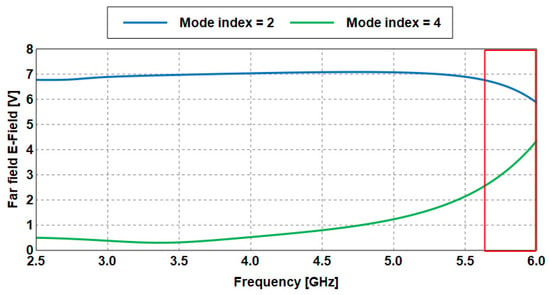
Figure 11.
Electric field of the proposed spring antenna based on CMA.
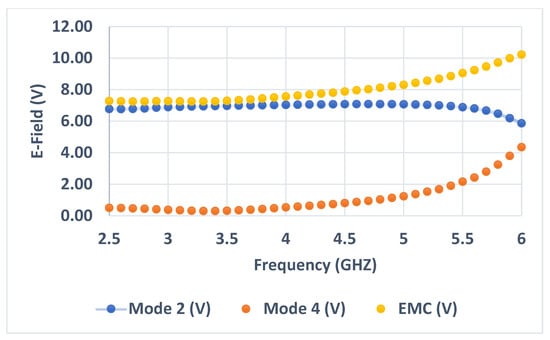
Figure 12.
EMC results of the proposed spring antenna based on CMA.

Table 2.
EMC results of the proposed spring antenna based on CMA.
The gains produced from the overall antenna indicate that the maximum gain is achieved at 5.77 GHz, as illustrated in the red box in Figure 13. This also agrees with the frequency where the maximum gain is obtained using the EMC-based CMA method.
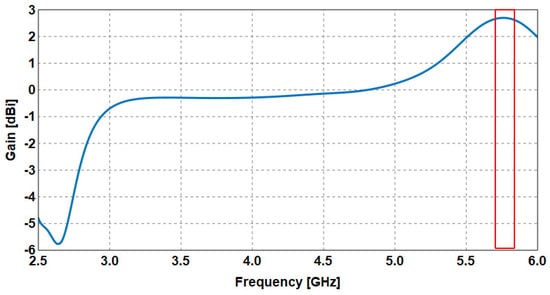
Figure 13.
Gain of the proposed spring antenna.
Several studies in the literature have proposed approaches to estimate the performance of antennas based on different equations and techniques, as summarized in Table 3. Most of these works depend on the analysis of the complete antenna (i.e., with substrate, ground, and excitation) or are derived from measurement data. Additionally, artificial intelligence-based approaches in the literature, such as machine learning (ML) and deep learning (DL) methods, also provide an accurate estimation of the performance of antennas. However, such methods require extensive knowledge of the application of such algorithms, and may potentially incur additional memory and processing costs depending on the structure complexity, number of parameters for optimization, and search range. In comparison, the proposed method enables an efficient, simple-to-understand, and reasonably accurate procedure to predict the maximum gain of the antenna. Being only dependent on the radiator structure without the effect of substrate and excitation, this also minimizes the needed time in the design and analysis process.

Table 3.
Comparison of the proposed method with other approaches in the literature.
A detailed comparison of the proposed antenna with other state-of-the-art flexible planar antennas from the literature operating in the same frequency range is summarized in Table 4. It can be observed that the proposed antenna featured an enhanced gain while being competitive in terms of compactness and bandwidth, as follows:

Table 4.
Performance comparison of the proposed antenna with other flexible antennas available in the literature (with λg = lower operating wavelength).
- a.
- The size of the antenna is more compact compared to antennas proposed in [,,,,].
- b.
- Its impedance bandwidth is improved compared to antennas proposed in [,,,,,,,,].
- c.
- Higher gains are achieved compared with most of the reported antennas in the literature at the relevant frequency (considering the equivalent electrical sizes).
3. Conclusions
This work describes an efficient design and optimization approach to improving the gain of a wearable antenna based on the CMA approach. Prediction of the forward gain is proposed based on the even mode combination method, which is derived based on the characteristic mode analysis. To predict the forward gain, the combination in the electric field of the first two even modes is computed. Two wearable antennas made using different flexible materials and fed using different feed types are used to validate this method. Both antennas are analyzed over ranges of frequencies from 2 to 6 GHz. Applying the EMC method, it can be observed that the maximum value of gain is achieved between 3.5 and 3.9 GHz, which is in good agreement with optimized values from full wave simulations (with substrate and excitation). Similarly, EMC analysis for the second wearable antenna designed on textile and fed using a microstrip line also enabled an accurate estimation of its maximum gain between 5.7 and 6 GHz. The simulated performance of the designed antenna is analyzed in terms of its reflection coefficient, radiation pattern, gain, and surface current. Both antennas are fabricated, and measurement results showed an acceptable agreement with simulations in terms of reflection coefficients and bandwidth. The first antenna operated from 2 to 5.27 GHz (measured) with gains of 8 dBi at 3.6 GHz, whereas the second antenna operated from 2.99 to 5.57 GHz (measured) and gain of 6 dBi at 3.5 GHz. Their operation in several important wireless frequencies, such as 2.45 GHz, 3.6 GHz, 5.5 GHz, and 5.8 GHz, and their flexibility enable them to be potentially applicable for WBANs, 5G, and IoT communications. The use of such a CMA-based approach can be extended in future works to include new methods to estimate the backward radiation of wearable antennas integrated with the artificial magnetic conductor (AMC). This will then also enable a more efficient prediction of the FBR parameter with less time cost by utilizing the features offered by CMA.
Author Contributions
Conceptualization, B.B.Q.E. and P.J.S.; methodology, B.B.Q.E. and P.J.S.; validation, B.B.Q.E. and P.J.S.; investigation, B.B.Q.E.; resources, P.J.S.; writing—original draft preparation, B.B.Q.E.; writing—review and editing, P.J.S.; visualization, B.B.Q.E.; supervision, P.J.S.; project administration, P.J.S.; funding acquisition, P.J.S. All authors have read and agreed to the published version of the manuscript.
Funding
This work was supported in part by the Academy of Finland through the 6G Flagship program under grant 346208 and in part by the Academy of Finland project LiBERATE under Grant 346949.
Data Availability Statement
Not applicable.
Conflicts of Interest
The authors declare no conflict of interest.
References
- Girija, H.S.; Sudhakar, R.; Kadhar, K.M.A.; Priya, T.S.; Ramanathan, S.; Anand, G. PSO Based Microstrip Patch Antenna Design for ISM Band. In Proceedings of the 2020 6th International Conference on Advanced Computing and Communication Systems (ICACCS), Coimbatore, India, 6–7 March 2020; pp. 1209–1214. [Google Scholar] [CrossRef]
- Li, E.; Li, X.J.; Zhao, Q. A Design of Ink-Printable Triband Slot Microstrip Patch Antenna for 5G Applications. In Proceedings of the 4th Australian Microwave Symposium (AMS), Sydney, Australia, 13–14 February 2020. [Google Scholar] [CrossRef]
- Li, T.; Dong, Y.; Fan, P.; Ben Letaief, K. Wireless Communications with RF-Based Energy Harvesting: From Information Theory to Green Systems. IEEE Access 2017, 5, 27538–27550. [Google Scholar] [CrossRef]
- Hussain, N.; Awan, W.A.; Naqvi, S.I.; Ghaffar, A.; Zaidi, A.; Iftikhar, A.; Li, X.J. A Compact Flexible Frequency Reconfigurable Antenna for Heterogeneous Applications. IEEE Access 2020, 8, 173298–173307. [Google Scholar] [CrossRef]
- Soh, P.J.; Vandenbosch, G.; Wee, F.H.; Van den Bosch, A.; Martinez-Vazquez, M.; Schreurs, D. Specific Absorption Rate (SAR) Evaluation of Textile Antennas. IEEE Antennas Propag. Mag. 2015, 57, 229–240. [Google Scholar] [CrossRef]
- Elias, B.B.Q.; Soh, P.J.; Al-Hadi, A.A.; Akkaraekthalin, P.; Vandenbosch, G.A.E. A Review of Antenna Analysis Using Characteristic Modes. IEEE Access 2021, 9, 98833–98862. [Google Scholar] [CrossRef]
- Bauer, J.E.; Gentner, P.K. Characteristic Mode Analysis of a Circular Polarised Rectangular Patch Antenna. In Proceedings of the 2019 13th European Conference on Antennas and Propagation (EuCAP), Krakow, Poland, 31 March–5 April 2019; pp. 1–3. [Google Scholar]
- Mahlaoui, Z.; Antonino-Daviu, E.; Latif, A.; Ferrando-Bataller, M. From the Characteristic Modes Analysis to the Design of a Radiation Pattern Reconfigurable Antenna. In Proceedings of the 2019 13th European Conference on Antennas and Propagation (EuCAP), Krakow, Poland, 31 March–5 April 2019; pp. 1–4. [Google Scholar]
- Phung, Q.Q.; Nguyen, T.H.; Michishita, N.; Sato, H.; Koyanagi, Y.; Morishita, H. Characteristic Mode Analysis of U-Shaped Folded Dipole Antenna for WiMAX. In Proceedings of the 2019 International Workshop on Antenna Technology (iWAT), Miami, FL, USA, 3–6 March 2019; pp. 105–107. [Google Scholar]
- Garbacz, R.; Turpin, R. A generalized expansion for radiated and scattered fields. IEEE Trans. Antennas Propag. 1971, 19, 348–358. [Google Scholar] [CrossRef]
- Harrington, R.; Mautz, J. Computation of characteristic modes for conducting bodies. IEEE Trans. Antennas Propag. 1971, 19, 629–639. [Google Scholar] [CrossRef]
- Harrington, R.; Mautz, J. Theory of characteristic modes for conducting bodies. IEEE Trans. Antennas Propag. 1971, 19, 622–628. [Google Scholar] [CrossRef]
- Singh, M.S.; Ghosh, J.; Ghosh, S.; Sarkhel, A. Miniaturized Dual-Antenna System for Implantable Biotelemetry Application. IEEE Antennas Wirel. Propag. Lett. 2021, 20, 1394–1398. [Google Scholar] [CrossRef]
- Si, L.-M.; Lv, X. CPW-Fed Multi-Band Omni-Directional Planar Microstrip Antenna Using Composite Metamaterial Resonator for Wireless Coomunications. Prog. Electromagn. Res. 2008, 83, 133–146. [Google Scholar] [CrossRef]
- Dwivedi, R.P.; Kommuri, U.K. CPW feed dual band and wideband antennas using crescent shape and T-shape stub for Wi-Fi and WiMAX application. Microw. Opt. Technol. Lett. 2017, 59, 2586–2591. [Google Scholar] [CrossRef]
- Liu, W.-C.; Wu, C.-M.; Chu, N.-C. A Compact CPW-Fed Slotted Patch Antenna for Dual-Band Operation. IEEE Antennas Wirel. Propag. Lett. 2010, 9, 110–113. [Google Scholar] [CrossRef]
- Hua, M.; Wang, P.; Zheng, Y.; Yuan, S. Compact tri-band CPW-fed antenna for WLAN/WiMAX applications. Electron. Lett. 2013, 49, 1118–1119. [Google Scholar] [CrossRef]
- Awan, W.A.; Hussain, N.; Naqvi, S.A.; Iqbal, A.; Striker, R.; Mitra, D.; Braaten, B.D. A miniaturized wideband and multi-band on-demand reconfigurable antenna for compact and portable devices. AEU—Int. J. Electron. Commun. 2020, 122, 153266. [Google Scholar] [CrossRef]
- Wu, R.; Wang, P.; Zheng, Q.; Li, R. Compact CPW-fed triple-band antenna for diversity applications. Electron. Lett. 2015, 51, 735–736. [Google Scholar] [CrossRef]
- Elias, B.Q.; Soh, P.J. Design of a Wideband Spring Textile Antenna for Wearable 5G and IoT Applications Using Characteristic Mode Analysis. Prog. Electromagn. Res. M 2022, 112, 177–189. [Google Scholar] [CrossRef]
- Shi, W.; Gao, J.; Cao, Y.; Yu, Y.; Liu, P.; Ma, Y.; Ni, C.; Yan, S. Gain characteristics estimation of heteromorphic RFID antennas using neuro-space mapping. IET Microw. Antennas Propag. 2020, 14, 1555–1565. [Google Scholar] [CrossRef]
- Guha, D.; Chattopadhya, S.; Siddiqu, J.Y. Estimation of Gain Enhancement Replacing PTFE by Air Substrate in a Microstrip Patch Antenna [Antenna Designer’s Notebook]. IEEE Antennas Propag. Mag. 2010, 52, 92–95. [Google Scholar] [CrossRef]
- Mistry, K.; Lazaridis, P.; Zaharis, Z.; Akinsolu, M.; Liu, B.; Loh, T. Accurate antenna gain estimation using the two-antenna method. In Proceedings of the Antennas and Propagation Conference, Atlanta, GA, USA, 7–12 July 2019; p. 29. [Google Scholar] [CrossRef]
- Reis, A.; Sarrazin, F.; Besnier, P.; Pouliguen, P.; Richalot, E. Contactless Antenna Gain Pattern Estimation from Backscattering Coefficient Measurement Performed within a Reverberation Chamber. IEEE Trans. Antennas Propag. 2021, 70, 2318–2321. [Google Scholar] [CrossRef]
- Wu, S.; Hughes, B.L. A principal-component approach to antenna impedance estimation at MISO receivers. IEEE Commun. Lett. 2023, 27, 288–292. [Google Scholar] [CrossRef]
- Liang, T.; Wang, Z.; Dong, Y. Estimation of axial ratio of single-port dual-mode circularly polarized antenna using reflection coefficient. IEEE Trans. Antennas Propag. 2023, 71, 1706–1715. [Google Scholar] [CrossRef]
- Krouka, W.; Sarrazin, F.; Besnier, P.; Richalot, E. Biased Estimation of Antenna Radiation Efficiency within Reverberation Chambers Due to Unstirred Field: Role of Antenna Stirring. IEEE Trans. Antennas Propag. 2022, 70, 9742–9751. [Google Scholar] [CrossRef]
- Klink, K.; Meyer, P.; Steyn, W. Efficient Yield Estimation of Multiband Patch Antennas Using NLPLS-Based PCE. IEEE Trans. Antennas Propag. 2022, 70, 7037–7045. [Google Scholar] [CrossRef]
- Sharma, R.; Potnis, A.; Chaurasia, V. Modelling of dielectric resonator based filtenna covering 2.5/2.6 (B41/n41) bands using machine learning algorithms. AEU—Int. J. Electron. Commun. 2023, 164, 154642. [Google Scholar] [CrossRef]
- Piltan, O.C.; Kizilay, A.; Belen, M.A.; Mahouti, P. Data driven surrogate modeling of horn antennas for optimal determination of radiation pattern and size using deep learning. Microw. Opt. Technol. Lett. 2023. early view. [Google Scholar] [CrossRef]
- Ali, E.M.; Awan, W.A.; Alzaidi, M.S.; Alzahrani, A.; Elkamchouchi, D.H.; Falcone, F.; Ghoneim, S.S.M. A Shorted Stub Loaded UWB Flexible Antenna for Small IoT Devices. Sensors 2023, 23, 748. [Google Scholar] [CrossRef] [PubMed]
- Yang, H.; Liu, X.; Fan, Y.; Xiong, L. Dual-Band Textile Antenna with Dual Circular Polarizations Using Polarization Rotation AMC for off-Body Communications. IEEE Trans. Antennas Propag. 2022, 70, 4189–4199. [Google Scholar] [CrossRef]
- Li, H.; Du, J.; Yang, X.-X.; Gao, S. Low-Profile All-Textile Multiband Microstrip Circular Patch Antenna for WBAN Applications. IEEE Antennas Wirel. Propag. Lett. 2022, 21, 779–783. [Google Scholar] [CrossRef]
- Yang, H.; Liu, X. Screen-Printed Dual-Band and Dual-Circularly Polarized Textile Antenna for Wearable Applications. In Proceedings of the 15th European Conference on Antennas and Propagation (EuCAP), Dusseldorf, Germany, 22–26 March 2021. [Google Scholar] [CrossRef]
- Zhou, L.; Fang, S.; Jia, X. Dual-band and dual-polarised circular patch textile antenna for on-/off-body WBAN applications. IET Microw. Antennas Propag. 2020, 14, 643–648. [Google Scholar] [CrossRef]
- Yang, H.; Liu, X. Wearable Dual-Band and Dual-Polarized Textile Antenna for on- and off-Body Communications. IEEE Antennas Wirel. Propag. Lett. 2020, 19, 2324–2328. [Google Scholar] [CrossRef]
- Yan, S.; Volskiy, V.; Vandenbosch, G.A.E. Compact Dual-Band Textile PIFA for 433-MHz/2.4-GHz ISM Bands. IEEE Antennas Wirel. Propag. Lett. 2017, 16, 2436–2439. [Google Scholar] [CrossRef]
- Sayem, A.S.M.; Simorangkir, R.B.V.B.; Esselle, K.P.; Hashmi, R.M. Development of Robust Transparent Conformal Antennas Based on Conductive Mesh-Polymer Composite for Unobtrusive Wearable Applications. IEEE Trans. Antennas Propag. 2019, 67, 7216–7224. [Google Scholar] [CrossRef]
- Hamouda, Z.; Wojkiewicz, J.-l.; Pud, A.A.; Kone, L.; Bergheul, S.; Lasri, T. Flexible UWB organic antenna for wearable technologies application. IET Microw. Antennas Propag. 2018, 12, 160–166. [Google Scholar] [CrossRef]
- Simorangkir, R.B.V.B.; Yang, Y.; Matekovits, L.; Esselle, K.P. Dual-Band Dual-Mode Textile Antenna on PDMS Substrate for Body-Centric Communications. IEEE Antennas Wirel. Propag. Lett. 2016, 16, 677–680. [Google Scholar] [CrossRef]
Disclaimer/Publisher’s Note: The statements, opinions and data contained in all publications are solely those of the individual author(s) and contributor(s) and not of MDPI and/or the editor(s). MDPI and/or the editor(s) disclaim responsibility for any injury to people or property resulting from any ideas, methods, instructions or products referred to in the content. |
© 2023 by the authors. Licensee MDPI, Basel, Switzerland. This article is an open access article distributed under the terms and conditions of the Creative Commons Attribution (CC BY) license (https://creativecommons.org/licenses/by/4.0/).